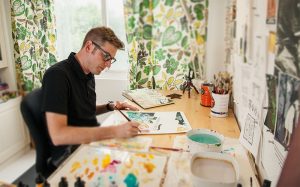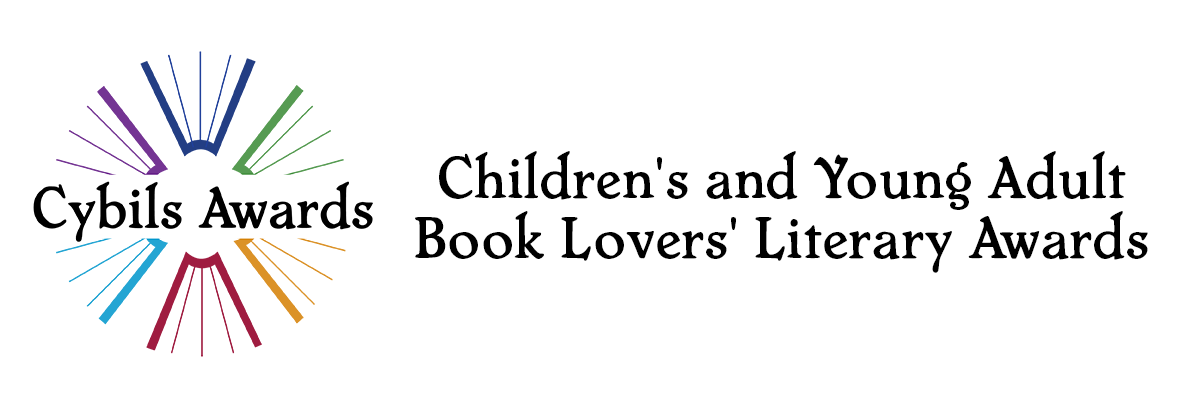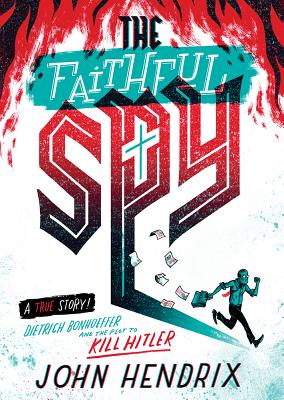There are so many World War II stories out there. What drew you to Dietrich Bonhoeffer’s life, and why did you choose to tell his story?
His story has been known to me for a long time. In my early 20’s I had read Dietrich Bonhoeffer’s theology in college, and knew of his journey, so I have always wanted to share this story, but working primarily as a picture book artist and writer, I couldn’t get the massive story to fit in that format… so I went with a longer middle grade prose/graphic novel hybrid. Seemed the right fit for the story. There are so many stories from WW2, what I liked about Bonhoeffer was the collision of ethics and action, faith and the world. Being a Christian myself, I think he asks some pretty relevant questions about where faith and action intersect in a broken world.
 One of the reasons our panel really loved The Faithful Spy was because of it’s unique format. Can you talk a bit about why you made the choices you did (hand-lettering text or the three color palette) for this story?
One of the reasons our panel really loved The Faithful Spy was because of it’s unique format. Can you talk a bit about why you made the choices you did (hand-lettering text or the three color palette) for this story? Thanks! Yes, these choices were a bit of a risk, but they were worth it to me because it really fit both my natural sense as a designer and the story. The design choices in the book were totally critical to the storytelling…. the color scheme was intentional to help tell the story in a visual form. I chose the red and teal to help show each of the stories in a clear visual signature, Hitler in red and Bonhoeffer in the teal. The colors are unsettling together, they create a kind of visual vibration, and as the two stories overlap, of Hitler and Dietrich, the colors overlap too, reinforcing the colliding content. The text is my handwriting, but the book is not handlettered (at least the body copy) I hired a designer/illustrator named John Martz to convert my handwriting to a typeface with 4 alternate glyphs per character that swap out at random to create a hand-drawn look. But the typeface offers some more consistency and makes translations to other languages easier too.
You’re an illustrator as well as an author. How does your art effect your writing and vice versa?
Well, no matter what I do, it always takes longer than I expect! For “The Faithful Spy”, I though that the writing would be much faster than the art making (I was used to the art taking so long, I thought that the writing would be much faster in contrast). I was very wrong in that department. Each process is time-consuming and requires tons of revisions. Looking back, that seems like a very obvious conclusion.. but yes, the process was long and full of changes. Writing books that you illustrate is a kind of tug of war between two narrative languages and I find that my goals shift back and forth as I’m writing and drawing. Many times, since I have the luxury, I will go back to my text and edit it to compliment the pictures in a richer way. Many times, that is actually removing, rather than adding. You always want to err on the side of letting the viewer complete the narrative in their mind, rather than turning the text into ‘captions’ for the illustration.
In the notes at the back of the book you talk about omissions (we found that hard to believe!). Is there a particular scene or event in Bonhoeffer’s life that you left out that you would love to have included?
So many to have included, one I mention in the end matter was the fact that Bonhoeffer was in correspondence with Ghandi, and nearly went to India to study with him, but felt his work in the Confessing Church was much more important. One of those little overlaps of history that is very noteworthy and sad to leave out. I also did not put much in about Russia and their part in WW2, which was critical to an allied victory, and yet I just didn’t have the narrative space for it.
If you don’t mind telling us, what’s next for you?
I’m hoping to revisit the longer middle grade format soon, but the project on my desk right now is a classic picture book. I am writing and illustrating a follow up to my 2016 book “Miracle Man: The Story of Jesus”. This book is a collections of some of Jesus’ parables and teachings, for young readers. Tentatively titled “Go and Do Likewise!,” it is scheduled to be out early 2020 from Abrams Books for Young Readers. I also have an illustrated collaboration with actor/writer Thomas Lennon, called “Ronan Boyle and the Bridge of Riddles” which came out in March 2019, and I’m working on the second book of that trilogy now. The series are middle grade chapter books about a magical police force in Ireland, and let me tell you, they are hilarious.

